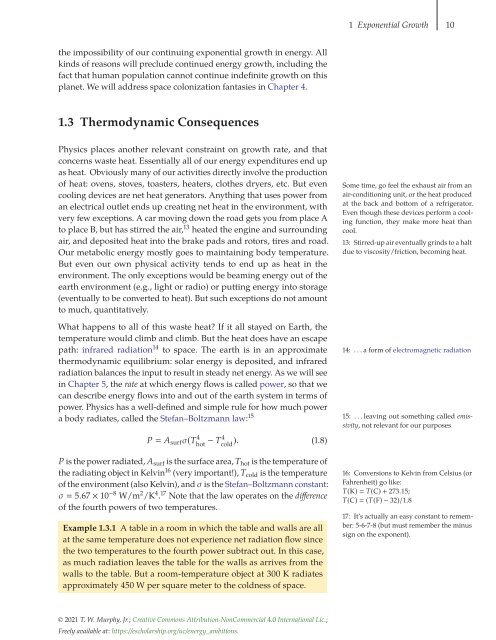Energy and Human Ambitions on a Finite Planet, 2021a
Energy and Human Ambitions on a Finite Planet, 2021a
Energy and Human Ambitions on a Finite Planet, 2021a
You also want an ePaper? Increase the reach of your titles
YUMPU automatically turns print PDFs into web optimized ePapers that Google loves.
1 Exp<strong>on</strong>ential Growth 10<br />
the impossibility of our c<strong>on</strong>tinuing exp<strong>on</strong>ential growth in energy. All<br />
kinds of reas<strong>on</strong>s will preclude c<strong>on</strong>tinued energy growth, including the<br />
fact that human populati<strong>on</strong> cannot c<strong>on</strong>tinue indefinite growth <strong>on</strong> this<br />
planet. We will address space col<strong>on</strong>izati<strong>on</strong> fantasies in Chapter 4.<br />
1.3 Thermodynamic C<strong>on</strong>sequences<br />
Physics places another relevant c<strong>on</strong>straint <strong>on</strong> growth rate, <str<strong>on</strong>g>and</str<strong>on</strong>g> that<br />
c<strong>on</strong>cerns waste heat. Essentially all of our energy expenditures end up<br />
as heat. Obviously many of our activities directly involve the producti<strong>on</strong><br />
of heat: ovens, stoves, toasters, heaters, clothes dryers, etc. But even<br />
cooling devices are net heat generators. Anything that uses power from<br />
an electrical outlet ends up creating net heat in the envir<strong>on</strong>ment, with<br />
very few excepti<strong>on</strong>s. A car moving down the road gets you from place A<br />
to place B, but has stirred the air, 13 heated the engine <str<strong>on</strong>g>and</str<strong>on</strong>g> surrounding<br />
air, <str<strong>on</strong>g>and</str<strong>on</strong>g> deposited heat into the brake pads <str<strong>on</strong>g>and</str<strong>on</strong>g> rotors, tires <str<strong>on</strong>g>and</str<strong>on</strong>g> road.<br />
Our metabolic energy mostly goes to maintaining body temperature.<br />
But even our own physical activity tends to end up as heat in the<br />
envir<strong>on</strong>ment. The <strong>on</strong>ly excepti<strong>on</strong>s would be beaming energy out of the<br />
earth envir<strong>on</strong>ment (e.g., light or radio) or putting energy into storage<br />
(eventually to be c<strong>on</strong>verted to heat). But such excepti<strong>on</strong>s do not amount<br />
to much, quantitatively.<br />
What happens to all of this waste heat? If it all stayed <strong>on</strong> Earth, the<br />
temperature would climb <str<strong>on</strong>g>and</str<strong>on</strong>g> climb. But the heat does have an escape<br />
path: infrared radiati<strong>on</strong> 14 to space. The earth is in an approximate<br />
thermodynamic equilibrium: solar energy is deposited, <str<strong>on</strong>g>and</str<strong>on</strong>g> infrared<br />
radiati<strong>on</strong> balances the input to result in steady net energy. As we will see<br />
in Chapter 5,therate at which energy flows is called power,sothatwe<br />
can describe energy flows into <str<strong>on</strong>g>and</str<strong>on</strong>g> out of the earth system in terms of<br />
power. Physics has a well-defined <str<strong>on</strong>g>and</str<strong>on</strong>g> simple rule for how much power<br />
a body radiates, called the Stefan–Boltzmann law: 15<br />
P A surf σ(T 4 hot − T4 cold<br />
). (1.8)<br />
P is the power radiated, A surf is the surface area, T hot is the temperature of<br />
the radiating object in Kelvin 16 (very important!), T cold is the temperature<br />
of the envir<strong>on</strong>ment (also Kelvin), <str<strong>on</strong>g>and</str<strong>on</strong>g> σ is the Stefan–Boltzmann c<strong>on</strong>stant:<br />
σ 5.67 × 10 −8 W/m 2 /K 4 . 17 Note that the law operates <strong>on</strong> the difference<br />
of the fourth powers of two temperatures.<br />
Example 1.3.1 A table in a room in which the table <str<strong>on</strong>g>and</str<strong>on</strong>g> walls are all<br />
at the same temperature does not experience net radiati<strong>on</strong> flow since<br />
the two temperatures to the fourth power subtract out. In this case,<br />
as much radiati<strong>on</strong> leaves the table for the walls as arrives from the<br />
walls to the table. But a room-temperature object at 300 K radiates<br />
approximately 450 W per square meter to the coldness of space.<br />
Some time, go feel the exhaust air from an<br />
air-c<strong>on</strong>diti<strong>on</strong>ing unit, or the heat produced<br />
at the back <str<strong>on</strong>g>and</str<strong>on</strong>g> bottom of a refrigerator.<br />
Even though these devices perform a cooling<br />
functi<strong>on</strong>, they make more heat than<br />
cool.<br />
13: Stirred-up air eventually grinds to a halt<br />
due to viscosity/fricti<strong>on</strong>, becoming heat.<br />
14: ...aformofelectromagnetic radiati<strong>on</strong><br />
15: . . . leaving out something called emissivity,<br />
not relevant for our purposes<br />
16: C<strong>on</strong>versi<strong>on</strong>s to Kelvin from Celsius (or<br />
Fahrenheit) go like:<br />
T(K) T(C) + 273.15;<br />
T(C) (T(F) − 32)/1.8<br />
17: It’s actually an easy c<strong>on</strong>stant to remember:<br />
5-6-7-8 (but must remember the minus<br />
sign <strong>on</strong> the exp<strong>on</strong>ent).<br />
© 2021 T. W. Murphy, Jr.; Creative Comm<strong>on</strong>s Attributi<strong>on</strong>-N<strong>on</strong>Commercial 4.0 Internati<strong>on</strong>al Lic.;<br />
Freely available at: https://escholarship.org/uc/energy_ambiti<strong>on</strong>s.


















